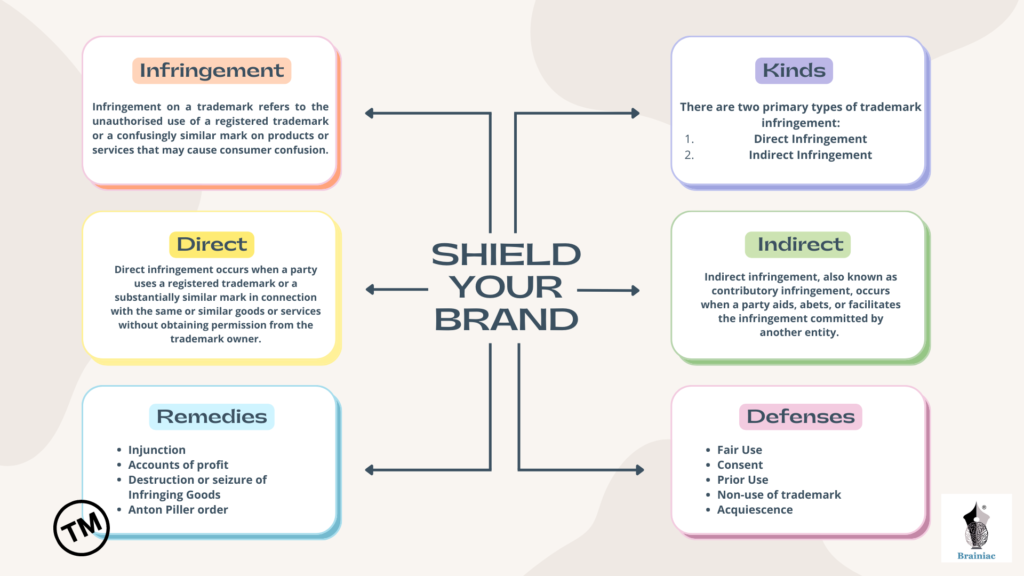Delving into the intricate world of trademark infringement, this comprehensive guide provides valuable insights into the types of infringement, available remedies, and defenses.
Introduction
Trademarks are valuable assets that distinguish products and services from competitors in the market. The unauthorized use of a trademark, known as trademark infringement, can cause significant harm to the brand owner’s reputation and business. Understanding trademark infringement, its types, remedies, and defenses, as well as the provisions in the Trademark Act 1999, is crucial for both trademark owners and potential infringers.
Trademark Infringement: Definition and Types
Infringement on a trademark refers to the unauthorised use of a registered trademark or a confusingly similar mark on products or services that may cause consumer confusion. There are two primary types of trademark infringement:
Direct Infringement
Direct infringement occurs when a party uses a registered trademark or a substantially similar mark in connection with the same or similar goods or services without obtaining permission from the trademark owner. The key elements of direct infringement are:
- Use of Registered Trademark: The infringing party uses an identical or confusingly similar mark that has already been registered as a trademark by another entity.
- Same or Similar Goods/Services: The infringing use involves offering products or services that are identical or closely related to those covered by the registered trademark.
- Likelihood of Confusion: The use of the infringing mark is likely to create confusion among consumers, leading them to believe that the products or services come from the same source as those associated with the registered trademark.
Example – Let’s consider a scenario where Company A, a well-established fashion brand, owns a registered trademark for its brand name ‘Glam Girl’ used for clothing and accessories. Another company, Company B, starts selling identical clothing and accessories under the name ‘Glam Girl’ without obtaining permission from Company A. This is a clear case of direct infringement as Company B’s use of a confusingly similar mark for the same type of products is likely to cause consumer confusion about the source of the goods.
Indirect Infringement (Contributory Infringement)
Indirect infringement, also known as contributory infringement, occurs when a party aids, abets, or facilitates the infringement committed by another entity. The key elements of indirect infringement are:
- Knowledge of Infringing Activity: The party knowingly aids, support, or goods to the primary infringer, fully aware of the infringement.
- Material Contribution: The assistance provided significantly contributes to the infringing activity, enabling the primary infringer to carry out the unlawful use of the trademark.
- Third-Party Infringement: The indirect infringer is not directly using the infringing mark themselves, but their actions enable or contribute to the infringement by a third party.
Example – Assume that Company C sells smartphone software applications under the trademark ‘TechWizards’ and has a registered trademark for its brand. Company D distributes unauthorised copies of Company C’s software applications to various retailers, despite being cognizant of Company C’s trademark. Company D does not explicitly use the ‘TechWizards’ mark, but its facilitation of the unauthorised distribution of the software contributes to the infringement. In this instance, Company D could be held liable for indirect infringement or contributory infringement for significantly contributing to the unauthorised use of the trademark by third parties.
Defenses against Trademark Infringement Claims
- Fair Use: The defence of fair use is crucial against trademark infringement claims. If the trademark is used for descriptive, nominative, or comparative purposes without the intent to deceive consumers, the use may be deemed fair and non-infringing. Using a trademarked name or logo to identify the original product for the purposes of comparison or review is typically regarded as fair use.
- Prior Use: The defence of prior use permits the alleged infringer to argue that they have been using the mark in question before the trademark owner, and therefore have prior rights to use the mark in a particular geographic area or for a specific set of goods and services. Prior use rights may be a valid defence if the infringing use occurred prior to the registration of the trademark.
- Consent: If the trademark owner has given express or implied consent for the use of their trademark, this can be a powerful defence against infringement claims. Consent may be granted in the form of a written agreement, licence, or other permissive communication.
- Abandonment or Non-Use: If the trademark owner has not actively used the registered mark for an extended period of time or has abandoned its use, the alleged infringer may assert that the mark has lost its distinctiveness and protection. To prove abandonment or non-use, the trademark proprietor must demonstrate a clear intent to stop using the mark.
- Genericism: The defence of genericism asserts that the trademark has become a generic term used to refer to an entire category of products or services, rather than designating the source of a specific product or service. Once a mark loses its distinctiveness and becomes generic, it is no longer protected.
- Acquiescence: Acquiescence occurs when the trademark proprietor actively permits the infringing use of their mark without taking legal action for an extended period of time. In such situations, the putative infringer may argue that the trademark owner’s silence and failure to enforce constitute implied consent.
Remedies for Trademark Infringement
Injunctions: The brand and reputation of the trademark owner may suffer irreversible damage from trademark infringement. To stop additional harm and potential consumer confusion, courts may impose interim or permanent injunctions to prohibit the infringing party from using the trademark. To swiftly stop unauthorised use and safeguard the goodwill connected with the brand, injunctions are a crucial remedy.
Damages: The owner of the trademark may seek monetary damages for losses incurred as a result of trademark infringement. Loss of revenue, real losses, and reputation injury to the brand are all examples of damages. Courts determine the degree of the infringement’s damage and provide the injured party with the proper monetary relief.
Accounts of Profits: The court may force the person who violated the trademark to account for any profits made from such usage in addition to awarding damages. This remedy guarantees that the offender does not profit from their illegal conduct and acts as an additional deterrence against similar offences in the future.
Destruction or Seizure of Infringing Goods: The destruction, confiscation, or seizure of products bearing the infringing trademark may be ordered by the court. This safeguard shields customers from purchasing possibly inferior or dangerous items and stops unlicensed or counterfeit goods from reaching the market.
Anton Piller Orders: A ‘search and seizure order,’ also known as an Anton Piller order, is a legal remedy that enables the trademark owner to perform a surprise examination of the infringer’s premises in order to gather proof of the infringement and save it for use in court. This order is beneficial in situations when there is a chance that evidence may be deleted if the infringer is forewarned.
Conclusion
For brand owners, trademark infringement is a major problem since it may damage their reputation and financial success. Both trademark owners and potential infringers must be aware of the different forms of infringement, applicable remedies, and defences. Businesses may safeguard their trademarks and preserve their unique character in the marketplace by taking proactive measures and making use of the Trademark Act 1999’s provisions. Unregistered trademark owners can protect their goodwill and brand reputation from dishonest business practices by being aware of passing off.



